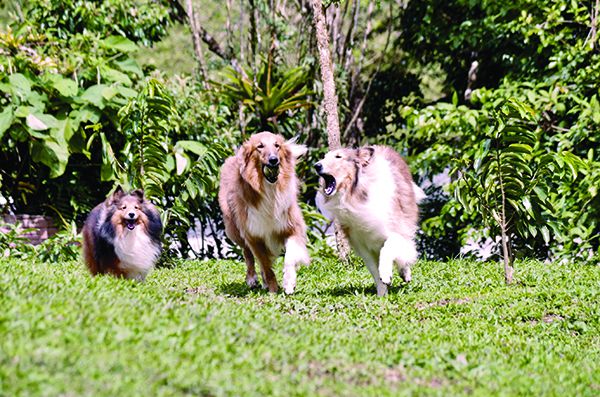Dog Barking: What You Can Do
Dogs bark for lots of different reasons. Dog barking may be triggered by strong emotional responses such as fear, reactivity, and aggression. These behaviors require significant attention to and modification for the underlying emotions that drive these behaviors.
But one of the most common types of barking happens just because the dog is excited and expresses her excitement in part through excessive vocalization. With these dogs, we can often go straight to working with the barking without having to spend lots of time and effort modifying an underlying behavior.
WHY ALL THE EXCITEMENT?
If your dog’s annoying, excessive barking stems from excitement, I can relate. Sunny, our Pomeranian/Eskimo-mix, is one of these. We had his voice pretty well under control until the arrival of our newest dog, KC, another Australian Kelpie (we already had one, Kai). KC’s energy has rejuvenated Sunny’s barking – and then some.
The first task is to determine what sets off the excitement barking and figure out how to manage the trigger – at least to the best of your ability. While it’s usually fairly simple to identify the trigger (or triggers), the second part – managing your dog’s exposure to the stimuli that make her bark – can be difficult.
DOG BARKING MANAGEMENT OPTIONS
One stratagem is to simply remove your barky dog from the exciting environment.
When KC and Kai play chase and tackle in the backyard, Sunny runs after them at full speed, barking shrilly. I don’t want to take away all of Sunny’s fun, so I let him chase and bark for a minute or two, then put him in the house so the other two can play in peace.
If your dog gets excited and barks when your kids are playing on the swing set, or friends hollering at the TV during football games, put her elsewhere during those events and let her come out again when the activity subsides.
Another option is to manage the trigger (rather than the barker). If I want Sunny to stay in the backyard, I can otherwise engage KC in playing with a Frisbee, which doesn’t incite Sunny to chase and bark. Similarly, you could take the kids to swing at the park or at their friend’s house, or ask someone else to host football parties, at least until you have modified your dog’s barking behavior.
It can also be helpful to increase your excited dog’s mental and physical exercise, to increase calm and decrease the amount of energy she has available to devote to barking. Structured physical exercise can serve to help improve your dog’s impulse control and is preferred over all-out random crazy exercise. (See “Impulse Control Exercises for High-Energy Dogs,” September 2017 and “Are Canines Cognitive?” October 2017.)
Finally, you may be able to manage in the moment by just feeding your dog very-high-value treats as you move her away from the excitement-causing stimulus. This is not likely to change her behavior in the long run but might get you out of an embarrassing situation.
Please note that “very high value” may vary from one dog to the next, but usually means something moist and meaty or cheesy. My favorite brand of packaged, non-perishable, non-greasy, easy-to-break-into-small-pieces treats are from the Real Meat Treat Company. “Very high value” for most dogs is definitely not some boring, dry, kibble-type treat.
MODIFICATION

Photo Credit: Sue Feldberg/ Dreamstime.com
There’s nothing wrong with good management; in fact, I have no problem with a dog’s family choosing to manage barking behavior for the dog’s lifetime. It might, however, be nice to not have to manage the barking always and forever. If you are motivated and willing to make the effort, there are some effective ways to modify barking behavior:
- Reinforce an alternative behavior. This suggestion entails giving the dog something to do – as opposed to just telling her to not do something else – and when she does the thing we’ve asked, we can give her reinforcement for the new, preferable behavior. Some suggestions for behaviors that make particularly good alternatives to barking include:
- Find it. Say, “Find it!” brightly, and toss treats at your feet. This helps your dog shift her focus from “out there” and whatever she was barking at to you and the area near you.
- Search. Just like “find it,” but you toss the treats away from you into the grass for your dog to find.
- “Go to Your Mat.” Some people may train their dogs to “station” themselves on a mat, bed, or cot, and remain there in any position (stand, sit, or down) until given a cue to move about freely again; others want this behavior to include lying down and relaxing. You can include whatever criteria you want, but the main thing is to give the dog a designated place to go to and await further instructions. (See “Mat Training Tips,” January 2020.)
- Settle. This behavior is more than a “down,” though we might start shaping it from that posture. The finished behavior should resemble a calm, completely relaxed dog, one who projects, “I’m going to be here for a while, so I may as well take a short nap,” rather than, “I’m holding a ‘stay,’ but at any moment I’m going to get a release cue and leap to my feet!” When she’s on the mat, reinforce her trained “Settle” behavior to help her learn to remain calm and stay on the mat even when exciting things are happening. (See “Teach Your Dog to Settle Down,” September 2015.)
- Touch. This cue asks your dog to touch her nose, a paw, or other body part to a target (such as your outstretched palm, a ball on the end of a pointer, or the lid of a plastic container taped to the wall). Use “Touch” to draw her attention away from whatever she’s barking at, and then engage her in some of her other favorite behaviors. (See “On Target Training,” September 2021.)
- Teach a “Quiet” cue. Also known as a “positive interrupt,” your cheerful “Quiet” cue simply invites your dog to cease barking in anticipation of receiving a reinforcer. If you have trained it well, it can work like a charm! (See “Punishment vs. Interruption,” February 2021.)Teaching a “Quiet” cue is simple: Start by reinforcing a very short bit of quiet – “short” as in one second! – and very gradually increase the amount of time you wait before giving your dog another reinforcer. It might help to count to yourself, “One one-thousand, two one-thousand…” If your dog barks as you are working on this, you are increasing the duration of her “quiet” behavior too quickly.This exercise has helped me with the resurgence of barking from our small dog, Sunny, prompted by the addition of another dog to our family. It requires a high rate of reinforcement, but I expect to eventually be able to decrease the rate of treat delivery as we had successfully done in the past to reduce his excitement barking.
- Ignore the bark and reinforce quiet. If you are in a situation where you can control the bark-eliciting stimulus, try ignoring your dog’s barking and reinforcing her when she is quiet. Sunny gets excited-barky when we are headed to the back door for a romp in the yard. When he barks, I stop my progress toward the door and turn around. When he stops barking, I say “Quiet, yes!” and drop a treat on the floor, then continue toward the door. If he barks again, we stop again. This, too, was working well for us – until KC arrived on the scene. This protocol does not work well if you aren’t in control of the bark-causing stimulus (say, a neighbor’s dog who won’t stop barking) or if you live in an apartment where your neighbors are likely to complain about any degree of ongoing barking.
- Invite your dog away from the trigger. “Walk away” is one of my favorite behaviors to teach. It means to quickly turn away from an object of focus for your dog and move away from it with you. Your dog is probably intensely focused on the stimulus that is inciting her excitement. Your well-trained, happy “walk away” cue will prompt her to do a 180-degree spin away from the stimulus and quickly move away from it with you. (See “How to Teach Your Dog to Just Walk Away,” September 2018.) You can then cue an alternative behavior (such as “Go to Mat,” above) so she doesn’t just return and resume barking.
Counter-conditioning and desensitization (CC&D)
This technique is used to change your dog’s association with a stimulus. While we are usually trying to change a dog’s negative association with a stimulus (whether it’s hat-wearing men, passing skateboards, small children, or anything else) to a positive one, we can also change a very high-excitement positive association to a still-positive but much calmer association. We start CC&D work with the dog’s stimulus at a low intensity (meaning it’s maintained at a distance or held to a low level of movement, for example, asking a friend to stand on a skateboard and move it just a little) and gradually increase the intensity (move the stimulus closer, allow the skateboarder to move a little more) until the dog has the new association with full-intensity presentation of the stimulus.
For the dog who barks non-stop at the child on the swing, you would start your CC&D with no one on the swing, at whatever distance is necessary for the dog to be able to remain calm in the presence of the swing. It’s important to start with the arousal-causing stimulus at a great enough distance from the dog so that she notices it but is not extremely aroused (this is called the threshold distance). As soon as the dog notices the swing, feed a few tiny bits of high-value treats. Pause the treat feeding, let her look at the swing again, and feed again.
This process is repeated until the presence of the swing consistently prompts your dog to look at you with a happy smile and a “Yay! Where’s my treat?” expression. This is a conditioned emotional response (CER) – your dog’s association with swings now means “Yay, treats!” instead of “Get excited!” Take care to keep your dog “under threshold” – happy and calm, and never pushed to the point of excited barking. Next you will gradually add increasing movement of the swing, eventually with a person on it.
Now you get to figure out how to apply the CC&D protocol in other bark-eliciting situations. Far from the pool, feed treats while people swim, then play gently, then do rowdy pool play. In another room, feed treats while friends converse while watching the football game, then get slightly excited, then more excited, and finally engage in Super Bowl-level excitement. You get the idea. And remember – you still have the option of putting your dog back in the house or in another room after you do a round of CC&D so your kids and/or friends can play/roughhouse/be rowdy to their hearts’ content.
YOUR CHOICE
You know your dog best, so you choose! You can skillfully manage your dog’s environment to minimize or even eliminate her excitement barking, and/or you can invest in a program of modification along with your management. Either way, eventually, your dog can learn that silence truly is chicken (golden) and peace can be restored to your household.





I have read some excellent stuff here. Certainly value bookmarking for revisiting. I surprise how much effort you place to create one of these great informative site.
Appreciate it for this post, I am a big fan of this site would like to go on updated.
Howdy! I simply would like to give you a huge thumbs up for the excellent information you have got here on this post. I’ll be returning to your website for more soon.
You made some nice points there. I looked on the internet for the subject and found most people will go along with with your site.
aviator jogo de aposta – https://jogodeaposta.fun/ melhor jogo de aposta para ganhar dinheiro